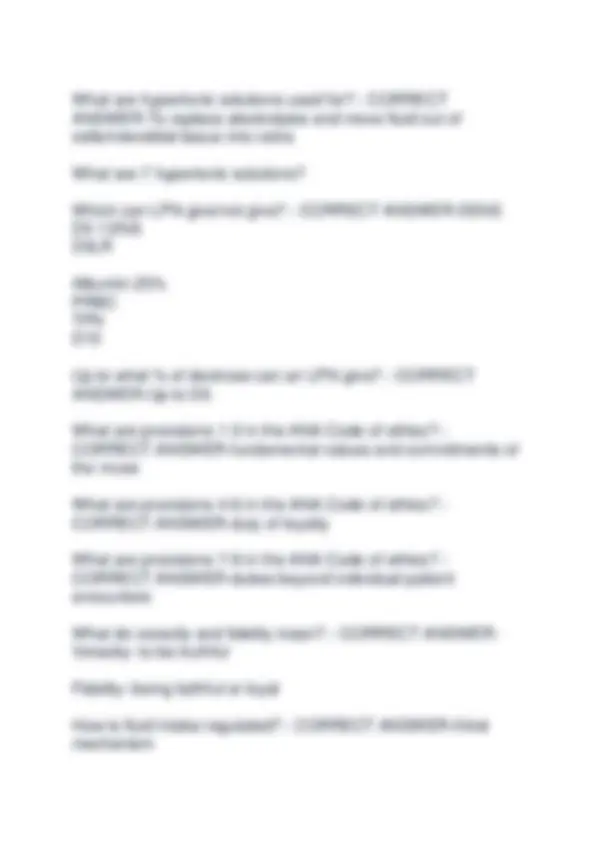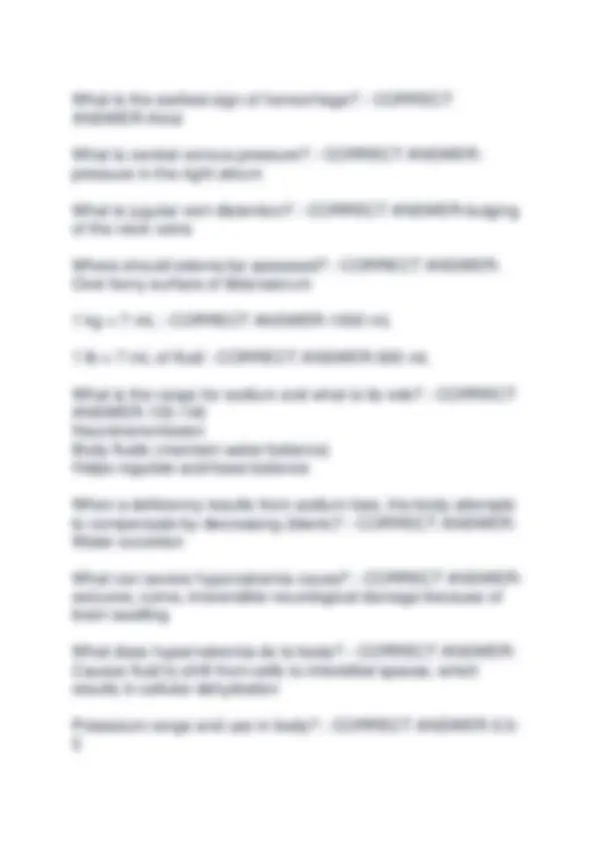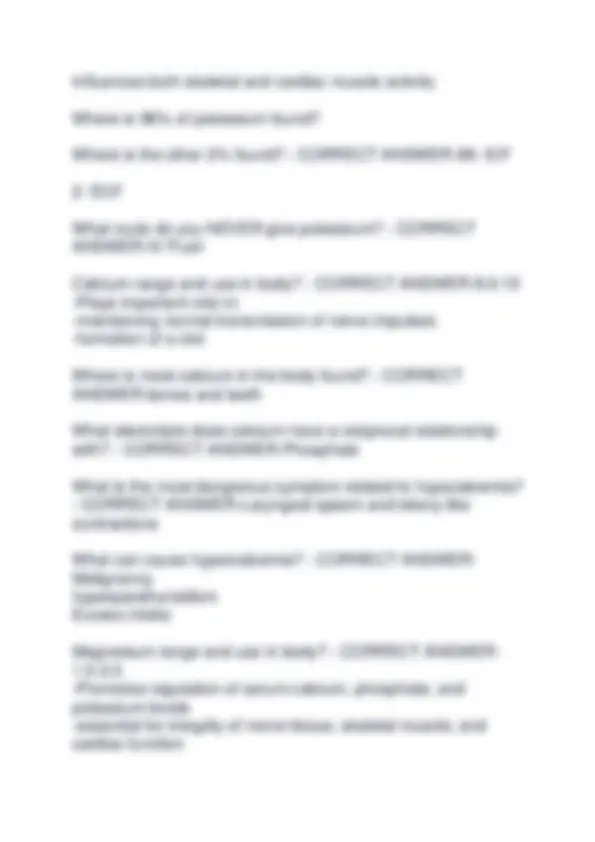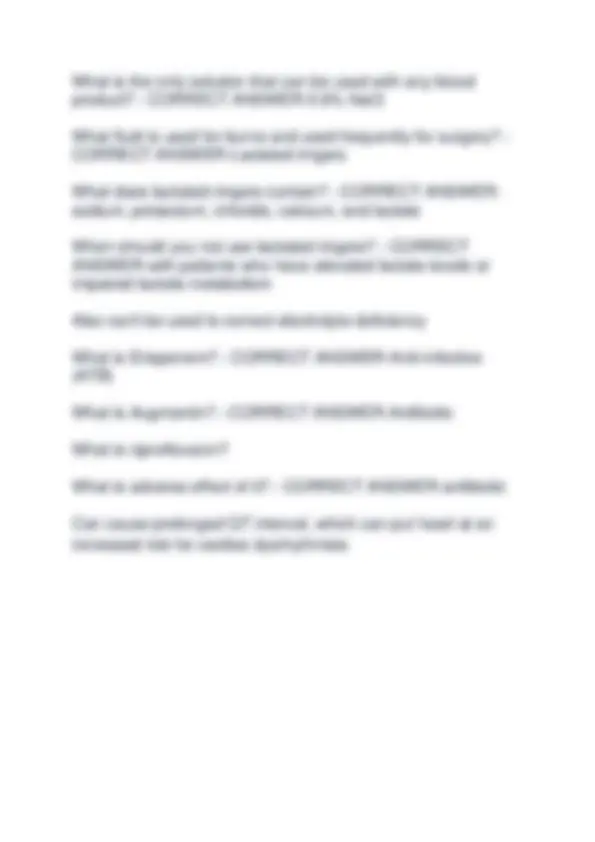






Study with the several resources on Docsity

Earn points by helping other students or get them with a premium plan


Prepare for your exams
Study with the several resources on Docsity

Earn points to download
Earn points by helping other students or get them with a premium plan
Community
Ask the community for help and clear up your study doubts
Discover the best universities in your country according to Docsity users
Free resources
Download our free guides on studying techniques, anxiety management strategies, and thesis advice from Docsity tutors
This comprehensive study guide for nursing 172 exam 1 covers essential concepts related to patient safety, fluid balance, electrolytes, and medication administration. It includes multiple-choice questions with correct answers, providing a valuable resource for nursing students preparing for their exam. The guide addresses topics such as national patient safety goals, malpractice claims, iv solutions, electrolyte imbalances, and common medications used in nursing practice.
Typology: Exams
1 / 8

This page cannot be seen from the preview
Don't miss anything!





What are the 2024 national patient safety goals? - CORRECT ANSWER-Identify pts correctly Identify pt safety risk Improve staff communication Improve health care equity Use medicines safely Use alarms safely Prevent infection Prevent mistakes in surgery What are the four elements of a malpractice claim? - CORRECT ANSWER-Duty Breach of duty Injury Causation (causal relationship, the breach of duty was the cause of harm to the patient) What are the 3 antiseptic solutions used for IV insertion? - CORRECT ANSWER--Alcohol based Chlorhexidine solution (the preferred antiseptic)
HypO- water flows out of vascular system into cells HypEr- water Enters the vasculature from cells What are the 5 isotonic solutions? - CORRECT ANSWER- NS=normal saline=0.9 NaCl LR=lactated ringers D5W=dextrose 5% in water Albumin 5% D5 1/4 NS What is the danger of isotonic solutions? - CORRECT ANSWER--Circulatory overload because fluids stay where they are infused and do not cause fluid shifts into other areas
What is the earliest sign of hemorrhage? - CORRECT ANSWER-thirst What is central venous pressure? - CORRECT ANSWER- pressure in the right atrium What is jugular vein distention? - CORRECT ANSWER-bulging of the neck veins Where should edema be assessed? - CORRECT ANSWER- Over bony surface of tibia/sacrum 1 kg =? mL - CORRECT ANSWER-1000 mL 1 lb =? mL of fluid - CORRECT ANSWER-500 mL What is the range for sodium and what is its role? - CORRECT ANSWER- 135 - 145 Neurotransmission Body fluids (maintain water balance) Helps regulate acid base balance When a deficiency results from sodium loss, the body attempts to compensate by decreasing (blank)? - CORRECT ANSWER- Water excretion What can severe hyponatremia cause? - CORRECT ANSWER- seizures, coma, irreversible neurological damage because of brain swelling What does hypernatremia do to body? - CORRECT ANSWER- Causes fluid to shift from cells to interstitial spaces, which results in cellular dehydration Potassium range and use in body? - CORRECT ANSWER-3.5- 5
Influences both skeletal and cardiac muscle activity Where is 98% of potassium found? Where is the other 2% found? - CORRECT ANSWER- 98 - ICF 2 - ECF What route do you NEVER give potassium? - CORRECT ANSWER-IV Push Calcium range and use in body? - CORRECT ANSWER-8.5- 10
What are the 3 main reasons IV solutions are administered? - CORRECT ANSWER--Resuscitation
What is the only solution that can be used with any blood product? - CORRECT ANSWER-0.9% NaCl What fluid is used for burns and used frequently for surgery? - CORRECT ANSWER-Lactated ringers What does lactated ringers contain? - CORRECT ANSWER- sodium, potassium, chloride, calcium, and lactate When should you not use lactated ringers? - CORRECT ANSWER-with patients who have elevated lactate levels or impaired lactate metabolism Also can't be used to correct electrolyte deficiency What is Ertapenem? - CORRECT ANSWER-Anti-infective (ATB) What is Augmentin? - CORRECT ANSWER-Antibiotic What is ciprofloxacin? What is adverse effect of it? - CORRECT ANSWER-antibiotic Can cause prolonged QT interval, which can put heart at an increased risk for cardiac dysrhythmias